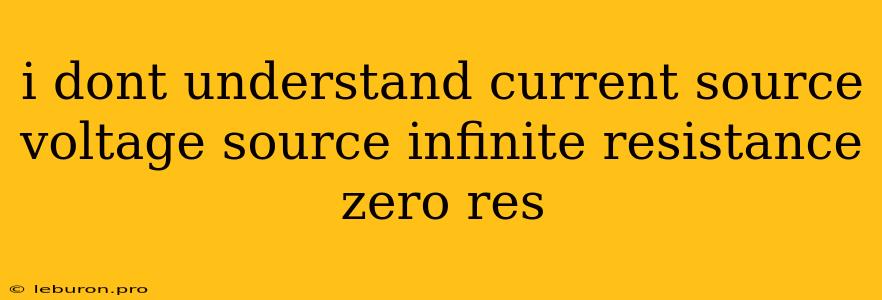Understanding the fundamental concepts of circuits, particularly the relationship between voltage sources, current sources, and resistance, is crucial for analyzing and designing electrical systems. One of the key concepts that often lead to confusion is the idea of an ideal current source having infinite resistance and an ideal voltage source having zero resistance. This article will delve into the concepts of voltage sources, current sources, and resistance to clarify their relationship and explain why the idealized characteristics of infinite resistance for a current source and zero resistance for a voltage source are essential.
Voltage Sources and Current Sources
To begin, let's define what we mean by a voltage source and a current source. A voltage source is a device that maintains a constant voltage across its terminals, regardless of the current flowing through it. Examples of voltage sources include batteries and power supplies. A current source, on the other hand, is a device that provides a constant current through its terminals, regardless of the voltage across it. While ideal current sources are difficult to realize in practice, we can approximate them using electronic circuits or specialized devices.
Understanding Resistance
Resistance is a fundamental property of materials that opposes the flow of electric current. In simple terms, a resistor is a component that limits the current flow through a circuit. The higher the resistance, the more it hinders the current flow. Resistance is measured in ohms (Ω).
Ideal Voltage Source and Zero Resistance
An ideal voltage source is characterized by zero resistance. This means that the voltage source does not impede the flow of current. A real-world voltage source, however, always has some internal resistance, known as source resistance. The smaller the source resistance, the closer the source is to being ideal.
Why is zero resistance desirable for a voltage source? Imagine a voltage source with a significant internal resistance. When a current flows through the source, a voltage drop occurs across this internal resistance, reducing the voltage available at the source's terminals. This means that the actual voltage delivered by the source is less than the intended value.
Ideal Current Source and Infinite Resistance
An ideal current source is characterized by infinite resistance. This means that no voltage drop occurs across the current source, regardless of the current it delivers. Practically, an ideal current source would maintain the same current output even if the load connected to it has an infinite resistance.
The infinite resistance of an ideal current source is crucial because it ensures that the current remains constant regardless of the load connected to it. If the current source had a finite resistance, any change in load resistance would affect the current flow. The higher the resistance of the current source, the less the current flow will be affected by changes in the load.
Consequences of Non-Ideal Sources
Real-world voltage and current sources deviate from the ideal model. A voltage source will have some internal resistance, which will cause a voltage drop across the source when current flows. Similarly, a current source will have a finite resistance, which will affect the current output depending on the load.
These deviations from ideal behavior can have significant consequences. For example, in a circuit with a voltage source and a load, a non-ideal voltage source with a high internal resistance may lead to a significant voltage drop across the source, reducing the voltage available for the load. This can cause the load to operate improperly or even fail.
Application in Circuit Analysis
The concepts of voltage sources, current sources, and resistance are fundamental to circuit analysis. Understanding these concepts is crucial for analyzing the behavior of electrical circuits, designing circuits, and troubleshooting problems.
By recognizing the ideal characteristics of voltage and current sources, we can simplify our circuit analysis. For example, when analyzing a circuit with an ideal voltage source, we can assume that the voltage across the source is constant and that the current flowing through the source is determined by the load.
Conclusion
The concept of infinite resistance for an ideal current source and zero resistance for an ideal voltage source is essential in understanding the behavior of circuits. These idealized characteristics allow for simpler circuit analysis and provide a framework for understanding the limitations of real-world sources.
While perfect voltage and current sources with zero and infinite resistance respectively are not physically achievable, understanding these concepts is vital for building accurate circuit models and designing efficient electrical systems.
